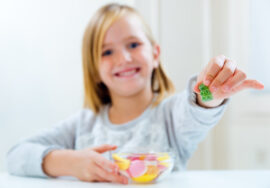
Mindful Eating for Children: How to Foster Healthy Relationships with Food
Introduction: Why Mindful Eating Matters for Kids
In today’s busy world, mealtimes often happen in front of a TV or while scrolling on a tablet. For children, this can lead to mindless eating, poor food choices, and an unhealthy relationship with food. Mindful eating—a practice of paying full attention to the eating experience—can help reverse these patterns.
Teaching mindful eating is an important step in supporting child health & wellness, as it encourages kids to listen to their bodies, enjoy their meals, and develop a balanced approach to nutrition that lasts a lifetime.
What is Mindful Eating?
Mindful eating is the practice of slowing down and focusing on the present moment during meals. It involves noticing the flavors, textures, and smells of food, as well as recognizing hunger and fullness cues.
For children, mindful eating is not about strict rules or dieting—it’s about building awareness and appreciation for food, reducing overeating, and fostering healthier food habits.
The Benefits of Mindful Eating for Child Health & Wellness
Mindful eating can bring multiple benefits to children’s physical and emotional well-being:
- Better Digestion: Eating slowly allows the body to process food more efficiently.
- Healthier Weight Management: Listening to hunger cues reduces overeating.
- Improved Food Choices: Children learn to enjoy a variety of flavors and textures, making them more open to healthy foods.
- Reduced Stress Around Meals: Mindful eating helps create a calm and enjoyable dining environment.
- Greater Body Awareness: Kids learn to understand how different foods make them feel.
Teaching Mindful Eating to Children
Helping children adopt mindful eating habits can be simple with consistent practice and positive reinforcement.
1. Eliminate Distractions During Meals
Encourage eating at the table without screens. Removing TVs, phones, and tablets helps children focus on the food and the company.
2. Encourage Slower Eating
Ask children to chew each bite thoroughly and set their utensils down between bites. This gives them time to recognize when they are full.
3. Explore the Senses
Invite children to describe the colors, smells, textures, and flavors of their food. This makes meals engaging and fun while building sensory awareness.
4. Teach Hunger and Fullness Cues
Help children understand the difference between physical hunger and emotional eating. Use a “hunger scale” from 1 (very hungry) to 10 (overly full) to guide portion control.
5. Involve Kids in Meal Preparation
When children help choose and prepare meals, they feel more invested in the food they eat. This also gives parents an opportunity to teach about balanced nutrition.
Mindful Eating Activities for Kids
Interactive activities can make mindful eating more appealing to children:
- Taste Testing Games: Offer a variety of fruits or vegetables and have kids guess the flavors with their eyes closed.
- Texture Challenge: Identify foods by their texture—crunchy, smooth, chewy, or soft.
- Food Stories: Talk about where food comes from, how it’s grown, and its benefits for the body.
Creating a Positive Mealtime Environment
The atmosphere at the table can influence a child’s eating habits. To support mindful eating:
- Keep conversations pleasant and free of criticism about food choices.
- Serve balanced meals that include a variety of food groups.
- Avoid pressuring children to finish everything on their plate, as this can override their natural hunger cues.
Integrating Mindful Eating into Daily Life
Mindful eating isn’t just for the dinner table—it can be part of daily routines:
- Pack lunches with a mix of healthy foods and encourage children to eat without multitasking.
- Practice mindful snacking by portioning out small servings instead of eating directly from the package.
- Encourage mindfulness during special occasions by savoring treats rather than overindulging.
Child Health & Wellness Products That Support Mindful Eating
Affiliate-friendly products can help parents promote mindful eating at home:
- Colorful Portion Plates to teach balanced meals visually.
- Child-Friendly Utensils that encourage slower eating.
- Healthy Snack Packs with pre-portioned servings for school and travel.
- Kids’ Cookbooks that focus on fun, healthy recipes.
- Bento Lunch Boxes to make nutritious meals appealing and organized.
These tools make it easier for families to encourage healthy eating habits from a young age.
Addressing Common Challenges
Parents may encounter obstacles when introducing mindful eating:
- Picky Eating: Use variety and creativity to make healthy foods appealing, such as turning vegetables into fun shapes.
- Busy Schedules: Even short, focused meals without distractions can help build mindful habits.
- Sugar Cravings: Offer naturally sweet alternatives like fresh fruit or yogurt instead of processed snacks.
The Long-Term Impact of Mindful Eating
Children who learn mindful eating early are more likely to carry these habits into adulthood, resulting in:
- Better weight management
- Reduced risk of lifestyle-related diseases
- Higher self-esteem and body confidence
- A healthier, more joyful relationship with food
Conclusion: Building Healthy Habits from the Inside Out
Mindful eating is more than a mealtime habit—it’s a life skill that nurtures both the body and mind. By incorporating mindful eating practices, parents can greatly enhance child health & wellness, encouraging children to appreciate food, listen to their bodies, and make healthier choices naturally.
In a world where fast food and screens often dominate, taking the time to slow down, savor, and connect over meals can have a profound impact on a child’s development, health, and happiness.







